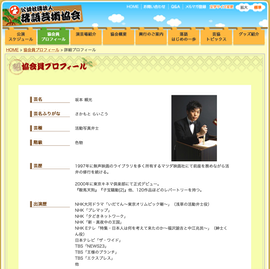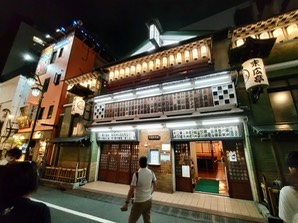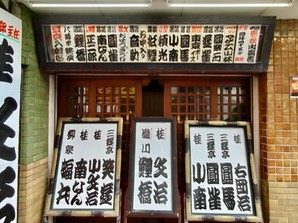
I am in Japan for the summer doing research and preparing for future projects. As I mentioned when advertising the Verbal Arts in Japan event at Yale, I have been seeing a lot of rakugo in Japanning recent years, especially at yose, the vaudeville halls that feature rakugo in addition to other entertainments such as magic, juggling, voice impersonation, etc. Even though I’ve been going to yose from before COVID, it is possible some of my current attraction is due to the desire to re-experience a communally shared present/presence in physical proximity. But there are research reasons as well, as I have been teaching and researching Japanese comedy as a whole.
It was interesting, however, to see that my interest in film and yose found an object in common this summer: not only the presentation of films in yose, but screening of them with a film benshi. The benshi Sakamoto Raiko, whom I’ve worked with before, joined one of the main rakugo organizations, the Rakugo Geijutsu Kyokai, as an iromono (those who are not rakugoka and appear in yose). I attach his GeiKyo profile above.

I was very curious about how he would do benshi performances in yose, where there are no film projectors and performers only have 10-15 minutes each. So in June, I went to the Suehirotei in Shinjuku to catch a bill with Raiko. Suehirotei is the oldest yose in Tokyo, at least in terms of the building, having been built right after the war. The photo on the left shows the front of that yose, with the names of famous performers listed below the lanterns. You can see the stage in the back through the door on the right.
In the photo on the right below, the day’s performers appear above the door, with some of the stars shown on the larger boards below. Raiko’s name is right in the middle of the placard on the top, with his name visible in the middle, and the words “katsudo benshi” written in red above.

Appearing in the middle of the show, Raiko literally came out carrying the screen as a zenza (a rakugo apprentice) lugged the video projector and began to sit it up. He began his talk the minute he stepped foot on stage, explaining what a benshi is as the equipment was being set up. He was carrying several DVDs and decided to show about a 10 minute abridged version of Ito Daisuke’s 1928 period film Chikemuri Takadanoba. Rakugo performers are known for deciding which story to narrate just before coming on stage, often by judging what the day’s audience might like, so I wonder if Raiko was doing something similar. I also wondered why he went with a serious samurai story over a comic one. They turned down the lights for his performance and Raiko narrated in the dark, standing next to the screen but sometimes walking about.
It so happens I saw Raiko again at the Suehirotei in July. This time he was placed on the bill right after the intermission (nakairi), which meant all the equipment was set up behind the curtain before it was raised and he appeared on stage. This time he picked a comic short: an abridged version of Monty Banks’s Play Safe (1927). While his version of Chikemuri was appreciated by the audience, this definitely went over quite well, especially as Raiko inserted current gags such as about the Bigmotor scandal.
The kodan performer Kanda Hakuzan had his crew record that day’s performance’s for his YouTube channel. Raiko appears at around 4:45 and 6:15. Also visible is Tamagawa Nanafuku, who came to Yale for Verbal Arts of Japan.
While I’d have to do more research to confirm whether benshi appeared in a yose bill during the silent era (unlikely, given issues with the projector), it is clear this is not something benshi have been doing over the last few decades. Raiko's appearance could testify to the continuing vibrancy of the benshi art, while also serving as an introduction to the art to many who would have otherwise never gone to a benshi show. By combing the live aspect of the film benshi with the liveness of the yose, Raiko is reminding us of one of the attractions of the benshi in the first place. At the same time, it prompts us to add a new chapter to the relationship between film and vaudeville-like entertainments that Henry Jenkins and others have discussed. You can check out Sakamoto Raiko’s page on on the GeiKyo website to see where he is next performing at a yose. He also occasionally does special events in combination with one or two rakugoka.

